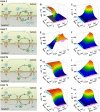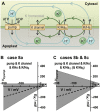Nutrient cycling is an important mechanism for homeostasis in plant cells
- PMID: 34890457
- PMCID: PMC8644529
- DOI: 10.1093/plphys/kiab217
Nutrient cycling is an important mechanism for homeostasis in plant cells
Abstract
Homeostasis in living cells refers to the steady state of internal, physical, and chemical conditions. It is sustained by self-regulation of the dynamic cellular system. To gain insight into the homeostatic mechanisms that maintain cytosolic nutrient concentrations in plant cells within a homeostatic range, we performed computational cell biology experiments. We mathematically modeled membrane transporter systems and simulated their dynamics. Detailed analyses of 'what-if' scenarios demonstrated that a single transporter type for a nutrient, irrespective of whether it is a channel or a cotransporter, is not sufficient to calibrate a desired cytosolic concentration. A cell cannot flexibly react to different external conditions. Rather, at least two different transporter types for the same nutrient, which are energized differently, are required. The gain of flexibility in adjusting a cytosolic concentration was accompanied by the establishment of energy-consuming cycles at the membrane, suggesting that these putatively "futile" cycles are not as futile as they appear. Accounting for the complex interplay of transporter networks at the cellular level may help design strategies for increasing nutrient use efficiency of crop plants.
© American Society of Plant Biologists 2021. All rights reserved. For permissions, please email: journals.permissions@oup.com.
Figures







References
-
- Ahmad I, Maathuis FJM (2014) Cellular and tissue distribution of potassium: physiological relevance, mechanisms and regulation. J Plant Physiol 171: 708–714 - PubMed
-
- Anschütz U, Becker D, Shabala S (2014) Going beyond nutrition: regulation of potassium homoeostasis as a common denominator of plant adaptive responses to environment. J Plant Physiol 171: 670–687 - PubMed
-
- Beilby M., Coster HG. (1979) The action potential in Chara corallina III. The Hodgkin-Huxley parameters for the plasmalemma. Funct Plant Biol 6: 337
-
- Beilby MJ (2007) Action potential in Charophytes. Int Rev Cytol 257: 43–82 - PubMed
-
- Beilby MJ, Al Khazaaly S (2016) Re-modeling Chara action potential: I. From Thiel model of Ca2+ transient to action potential form. AIMS Biophys 3: 431–449
Publication types
MeSH terms
Substances
LinkOut - more resources
Full Text Sources

